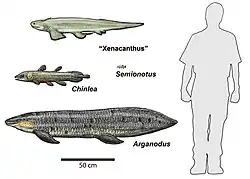Arganodus
Arganodus is an extinct genus of Ceratodontidae (lungfish). It´s fossils where found first at Tizi n'Maâchou in the Marrakech area of Morocco, in rocks of the Timezgadiouine Formation, that belong to the Argana Group (hence the generic name).[1] Other specimens have been found in the Redonda Formation, New Mexico,[2] the Anoual Formation of Morocco,[3] the Tacuarembó Formation of Uruguay,[4] and the Cumnock Formation, North Carolina,[5] although the North Carolinian specimens are smaller than most recorded specimens.[5] Fossils have also been uncovered in the Petrified Forest National Park.[6] It was first named by Martin in 1979, and contains two species, A. dorotheae and A. atlantis. In 1984, Martin described Arganodus tiguidiensis from Elrhaz Formation of Niger extending its stratigraphic range from the Upper Jurassic to the Cenomanian.[7] Later, this species was assigned to the genus Asiatoceratodus by Kemp (1998).[8]
| Arganodus Temporal range: Late Triassic-Late Jurassic | |
|---|---|
 | |
| Arganodus (bottom) and other fish from the Chinle Formation | |
| Scientific classification | |
| Kingdom: | |
| Phylum: | |
| Class: | |
| Order: | |
| Family: | |
| Genus: | Arganodus Martin, 1979 |
| Species | |
| |
Paleoecology
Arganodus was probably similar to modern lungfish, and lived in underwater burrows during dry periods until monsoons occurred.[6]
References
- Martin, M. (1979). "Arganodus atlantis et Ceratodus arganensis, deux nouveaux Dipneustes du Trias supérieur continental marocain [Arganodus atlantis and Ceratodus arganensis, two new dipnoans from the continental Moroccan Upper Triassic]". Comptes Rendus de l'Académie des Sciences à Paris. 289: 89–92.
- "The Microvertebrate Fauna of Shark Tooth Hill, Redonda Formation (Late Triassic, Apachean), Quay County, New Mexico". Andrew B. Heckert, Spencer G. Lucas and Adrian P. Hunt, New Mexico Museum of National History. 2005. Archived from the original on 2 June 2008. Retrieved 2008-07-14.
- Haddoumi, Hamid; Allain, Ronan; Meslouh, Said; Metais, Grégoire; Monbaron, Michel; Pons, Denise; Rage, Jean-Claude; Vullo, Romain; Zouhri, Samir (January 2016). "Guelb el Ahmar (Bathonian, Anoual Syncline, eastern Morocco): First continental flora and fauna including mammals from the Middle Jurassic of Africa" (PDF). Gondwana Research. 29 (1): 290–319. doi:10.1016/j.gr.2014.12.004. ISSN 1342-937X.
- Soto, M., and D. Perea. 2010. Late Jurassic lungfishes (Dipnoi) from Uruguay, with comments on the systematics of Gondwanan ceradontiforms. Journal of Vertebrate Paleontology 30. 1049-1058. .
- "A New Microvertebrate Fauna from the Upper Triassic (Norian) Cumnock Formation, Durham Subbasin, North Carolina, USA". Andrew B. Heckert, Vincent Schneider, Paul E. Olsen, and Sterling Nesbitt. 2006. Retrieved 2008-07-15.
- "Petrified Forest National Park - Vertebrates of the Late Triassic (U.S. National Park Service)". www.nps.gov. 2007-04-13. Archived from the original on 12 June 2008. Retrieved 2008-07-15.
- Martin, M., 1984. Révision des Arganodontidés et des Néocératodontidés (Dipnoi, Ceratodontiformes) du Crétacé africain. Neues Jb. Geol. Paläontol. Abh. 169, 225–260.
- Kemp, A. 1998. Skull structure in post-paleozoic lungfish. Journal of Vertebrate Paleontology, 18(1): 43-63.
External links
- Arganodus at the Paleobiology Database
- Arganodus at Zipcodezoo.com
- The Geographic Distribution and Biostratigraphy of Late Triassic-Early Jurassic Freshwater Fish Faunas of the Southwestern United States
- www.texasfinearts.com
- Preliminary Review of the Early Jurassic (Hettangian) Fresh Water Lake Dixie Fish Fauna in the Whitmore Pointmemeber, Moenave Formation in Southwest Utah
- The Moncure Microvertibrate Fauna (Upper Triassic: Norian), Colon Cross-structure/Sanford Sub-basin, North Carolina, USA

